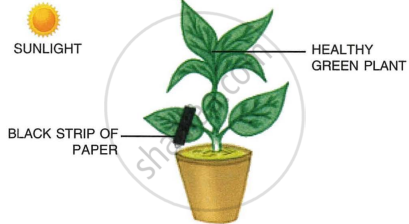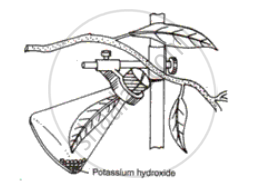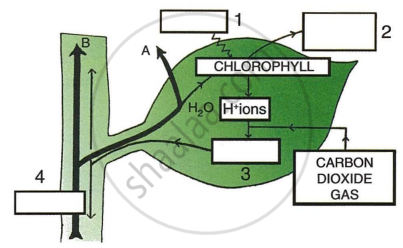Advertisements
Advertisements
प्रश्न
Given below is the figure of an experimental set-up, showing a physiological act of the plants. Study and answer the following questions:

- What is the objective of this experiment?
- Name and define the process shown here.
- Why do we destarch the leaves before performing the experiment?
- How do we destarch the leaves?
- What will be the observation when we pour iodine solution over the bleached experimental leaf?
- Write a well-balanced equation for the above process.
उत्तर
- To demonstrate the need for sunlight for photosynthesis.
- With the aid of water and carbon dioxide, photosynthesis is the process by which plants create food glucose, facilitated by the presence of plants' chlorophyll pigment in sunlight. Products from photosynthesis are glucose and oxygen. Plants employ glucose to drive their cellular functions; other species need oxygen to respire.
We destarch a plant such that photosynthesis takes place in the sunshine. If the leaves already contain starch, photosynthesis does not take place. - The leaves will destarch if we put them in a dark room for 24 to 48 hours. Darkness lets the plant consume any pre-existing starch kept in the leaves and stops photosynthesis.
- The bleached experimental leaf will assume a blue-black hue when iodine solution is applied to it, indicating the presence of starch. The absence of a colour change (the leaf remains brown) would suggest that the leaf is starch-free.
- \[\ce{6CO2 + 6H2O ->[Sunlight][Chlorophyll] C6H12O6 + 6O2}\]
संबंधित प्रश्न
An experiment was set up as shown in the figure given below . The twig in the diagram was intact on the plant and it was as such in sunlight for a few hours .

(i) What is the aim of the above experiment ?
(ii) Why was potassium hydroxide placed inside the conical flask ?
(iii) What test would you perform on the leaf inside the flask?
(iv) What is the expected result of the above test ?
(v) Is it necessary to similarly test on outer leaf also ? Giva a reason .
Given below is a schematic diagram to illustrate some aspects of photosynthesis.
- Fill up the gaps, in blank spaces (1-4), by writing the names of the correct items.
- What phenomenon do the thick arrows A and B indicate?

Given below is the representation of a certain phenomenon in nature. With four organisms 1-4.

Name the biological process which was the starting point of the whole chain.
Given below is the representation of a certain phenomenon in nature. With four organisms 1-4.

Name one natural element which all the organisms 2-4 and even 5 are getting from No. 1 for their survival.
The diagram below shows two test-tubes A and B. Test-tube A contains a green water plant. Test-tube B contains both a green water plant and a snail. Both test-tubes are kept in sunlight. Answer the questions that follow:

(a) Name the physiological process that releases the bubbles of oxygen.
(b) Explain the physiological process as mentioned above in (a).
(c) What is the purpose of keeping a snail in test-tube B?
(d) Why does test-tube B have more bubbles of oxygen?
(e) Give an example of a water plant that can be used in the above experiment.
(f) Write the overall chemical equation for the above process.
Complete the following sentence with appropriate word:
________molecules of chlorophyll make one quantasome.
Complete the following sentence with appropriate word:
Carbon dioxide enters the leaf through _______.
Choose the Odd One Out
Match the terms given in column A with column B:
| Column A | Column B | ||
| (a) | Chlorophyll | (i) | Removes/absorbs CO2 |
| (b) | Methylated spirit | (ii) | Tests presence of starch |
| (c) | Potassium hydroxide | (iii) | Traps solar energy |
| (d) | Iodine solution | (iv) | Produces oxygen |
| (e) | Water | (v) | Bleaches chlorophyll |
